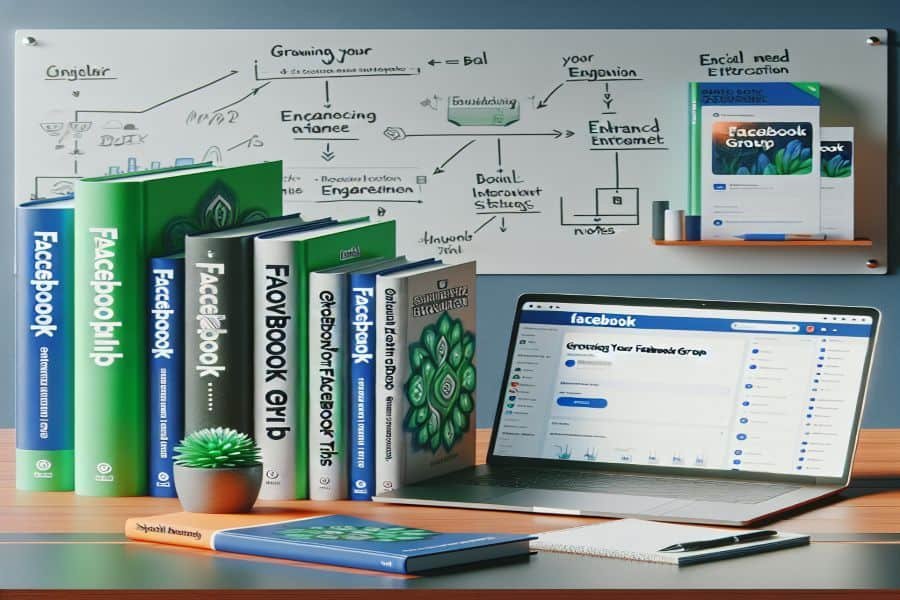Here are the secret tactics that work to grow a Facebook group for business engagement: Engage your audience, build connections, and raise brand awareness. However, 2.9 billion people are still active on the platform, and it sure makes sense for brands to connect with focused groups using this site. Facebook groups developed as essential utilities for community building, network expansion, and engagement. It is a special platform for startups, content creators, & promoters within the social media circuit to connect with their audience. The possibilities for leveraging these fan groups into sales and brand power are endless. In this blog post, we will guide you through the very basic steps on how to grow a Facebook group and scale. You will learn how to engage, what FB functionalities can be exploited, and finally, grow the network.
Know Your Audience/Niche
You should know what your audience is interested in and tap into a niche that will directly relate to them before you start a Facebook group. Choose a niche you are also familiar with, and your clients will be too. Only then will you research their interests, behaviors, and preferences. The social platforms you are using and the analytics tools at your disposal can present very useful information relevant to what is considered noteworthy by your audience. Picking the best niche will undoubtedly draw in people who want to digest articles.
Facebook Audience Insights gives marketers the information they need so they can learn more about the people who are engaging with their content by providing information about demographic and behavioral data. It aids in discovering audience interests, age, gender, location, and device usage. This helps advertisers to better run and refine their Facebook advertising campaigns and lead more tailored and higher-performing ads.
Secondly, your niche should make you feel like part of a community and give others the sense that they belong just as effortlessly. Secondary Posted in software development. Instead of a general fitness group, go for “vegan strength training. It helps further define your USP (unique selling proposition) and how your group is different from others.
Finally, consider adding a survey or poll to engage potential members and get feedback on what you plan will pique their interests. Use that input to shape the direction of your group so you are always in alignment with who you want for an audience.
Creating Your Facebook Group
While building a Facebook group is simple, making it successful takes some thought and setup. First, give your group a creative and catchy name that realistically describes its purpose. This is the first thing potential members will come across, so let them remember this name.
Now, you can configure privacy restrictions according to your group’s needs. Public groups are easily discoverable and receive higher visibility, while private ones offer exclusivity in designing an exclusive community. Balance this accordingly with your scaling objectives.
Add a detailed but precise group description with keywords that can be indexed for SEO. This space is your chance to set out the group’s mission, rules, and what you expect from fellow members. A good cover photo can help them boost their quality and notoriety.
Lastly, all engagement is great, so start off by making an introduction post. Announce yourself and share what you would like to do in this group. Welcome, new members. Members can be invited to share their stories or make introductions, which would increase initial interaction and create a sense of belonging. Following these steps will set the foundation for how to grow a Facebook group effectively, building a vibrant and engaging community from the outset.
Expanding Your Group Naturally

A Facebook group can only run successfully with organic growth. Just start by inviting your first members from personal and professional circles. Tell them to ask anyone who might want to join. Word-of-mouth and personal recommendations are the two best ways of growing your group.
Instead, try to craft content that is so engaging that people have no choice but to desire to welcome others. Post a lot but routinely to keep the group busy and kicking. Keep the content valuable. The first rule is that content should be informative regarding your industry and strike a chord with your audience. Vary the ways you distribute your content (e.g., written articles, videos, or infographics).
Use social media groups, blog posts, and email newsletters to promote your group. These channels allow you to broaden your audience and attract members who may not have found out about your group through Facebook only. Alternatively, think about cross-promoting with other pages by making partnerships to reinforce visibility and attract more people with the same interests.
Content and engagement strategies that work
They are, indeed, the lifeblood of any successful Facebook group—engagement. Contributing posts is important, but so is increasing these kinds of interactions with other members. Step 1: Post regularly (consistent posting schedule). By keeping your group active with regular content, you can motivate members to come back for new information.
Respond quickly to member comments and inquiries. Recognizing their efforts and contributions instills confidence in them to keep participating. Use polls, going live, and discussion prompts to encourage comments in conversations with each other inside the group.
Themed Content Days —”Organization & Anticipation” For instance, “Tip Tuesdays” or something like “Feedback Fridays,” this engenders a habit for both you and your community to drop in with responses. Continue to analyze the types of content with high engagement and re-calibrate your strategy.
Facebook Features for Group Scaling

Facebook has options to improve group functionality, and these are only a few of the tools available to us as admins. This includes the “Units” category, which categorizes content into sections or modules. This is especially useful for groups with a strong educational or resource focus since it allows them to deliver material in an organized style.
Use the events function to plan webinars, Q&A sessions, or virtual meet-ups. Such events can drive group activity, incentivize participation, and give members more for their membership than just access to the channel itself. You can also bring in guest speakers or industry experts for a different perspective and to gain new members as they promote their participation.
A great feature of this part is the “Announcements,” which pins important posts on top of the feed. Please turn it off for feature updates, guideline changes, or the first things you want to be pinned. This flow includes the ability to stay up-to-date with various tasks, and effective communication lets everyone involved in a project know what is going on.
How to grow a Facebook Group: Success Measurement and Iteration
Measuring success is essential to mastering how to grow a Facebook group effectively. Monitor specific indicators like the size of your membership, how active they are, and what percentage is actively participating in group functions. These metrics quickly tell you how your group is doing and where it can get better.
Use Facebook Group Insights, a built-in feature to study member demographics and track the most-used content or peak activity times. This information can help you with your content strategy to better align it with what resonates with your audience.
Use your poll or questionnaire in every meeting to strike a balance with feedback from members of the group. I value their input about what they most appreciate and also where there is room for improvement. Take this feedback and modify the things that you are delivering to keep offering value to your group.
We will also mention some use cases or success stories. Real-life instances of Facebook Groups Rockstar Success Stories can push you to go an additional mile with your area-building mindset. Just look at the Tech Entrepreneurs Group, which went from zero to over 10,000 members in a mere six months. This helped them to draw in a community of high-value members who shared a common interest—the group grew rapidly on its own by providing knowledge and resources that were specific only for tech startups.
So, too, did the Health and Wellness Community experience rewarding organic growth after incorporating fun daily challenges, weekly live Q&A sessions with experts, and a very welcoming support group for their members to go from 100 new members in its first month of use to over 2k just one year later. The group began to grow in terms of both numbers and engagement because this resonated with their target customer, who was interested in holistic health and wellness experiences.
This week, we are looking at a live local business networking group and how they show us the power of in-person events. In two years, the group went from 500 members to over 5,000 by focusing on local support and collaboration and sharing success stories. Using face-to-face keywords reinforced relationships and helped perpetuate a feeling of neighborhood.
References And More Resources

Facebook for Business Blog: A great view of how you can use Facebook groups.
Pew Research Center: A treasure trove of data and reports on social media usage and trends.
Harvard Business Review: If you fancy herbal slimming teas in this FCC (from Cabbage Cream) world, here are some articles on niche marketing and audience segmentation.
Buffer: Audience Research Tricks and Tips for Today. Official Facebook Policy Guide on Setting Up and Running a Group
Sprout Social: It is a social media management tool that features some advice on group administration.
HubSpot: In-depth social media stats and tactics for organic growth. Social Media Examiner Facebook Group Growth Finally, you might need to read this excellent blog post about growing and engaging with your Facebook groups. The Community Roundtable: Insights into member engagement best practices.
Hootsuite: A complete guide to social media strategy, including tips on how your company may use Facebook to increase engagement.
Conclusion
Following which, the potential of Facebook groups to build community, engagement, and network growth is unquestionable! Learn about your audience, strategically devise your group setup, and leverage Facebook tools so that you can understand success as a community that gives value to its members.
As with all things, be consistent in both content and engagement. It’s not just about posting content but also consistency and engagement within your community. By following the strategies in this guide on how to grow a Facebook group, you can be sure that your group growth and community building efforts will reach exceptional levels!
FAQ’s
1. What is the main function of a Facebook group?
Facebook groups are a community where people come and interact and share ideas to have productive discussions. They are a place for people to come together around any given issue or activity.
2. What can I do to keep my group active and interested?
Turning a group active and engaged is an ongoing process. Regularly make posts, engage with your members as they interact, and get the opportunity to discuss. Promote the sharing of personal stories and knowledge by members, as well as organizing live events or webinars to maintain interactivity within the group.
3. Which mistakes to avoid when launching your Facebook group?
I have seen that member engagement, mediocre posting, and lack of a clear niche are some common things that need to be added to groups. In addition, try not to use the group just as a promotional platform for your own product; otherwise, it can put off serious engagement. Instead, add value and build a community.
